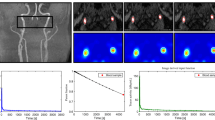Summary
Proliferative activity of meningiomas was examined in 12 consecutive cases by administering bromodeoxyuridine (BrdU) before surgical removal and by immunohistochemical staining of the removed tumours using anti-BrdU monoclonal antibody (anti-BrdU MAb) to detect BrdU-labelled tumour cells. The 12 cases consisted of 6 with a primary tumour and 6 with a recurrent tumour. All of the tumours contained labelled cells and the labelling index (LI) was obtained in each tumour. The highest average LI was 13.6% and the second highest was 9.0% both in recurrent cases of histologically malignant meningothelial meningioma. The high LIs of both cases were thought to correspond well with the rapid recurrence of the tumour. The average LI of a case of recurrent haemangiopericytic tumour was 2.0%, and that of a case of meningioma associated with von Recklinghausen disease was 1.5%. The other 8 meningiomas showed the average LIs ranging from 0.1 to 0.9%, which were considered to be the LIs of usual benign meningiomas.
The results of the BrdU uptake examination was considered to reflect well the clinical behaviour of meningiomas. The usefulness of the BrdU uptake examination in brain tumours, which can be employed in the clinical practice without any serious side-effects, is stressed.
Similar content being viewed by others
References
Bagshow MA, Doggett RLS, Smith KC, Kaplan HS, Nelson TS (1967) Intra-arterial 5-bromodeoxyuridine and X-ray therapy. Am J Roentgenol 99: 886–894
Dean NP, Dolbeare F, Gratzner H, Rice GC, Gray JW (1984) Cell-cycle analysis using a monoclonal antibody to BrdUrd. Cell Tissue Kinet 17: 427–436
Dolbeare F, Gratzner H, Pallavicini MG, Gray JW (1983) Flow cytometric measurement of total DNA content and incorporated bromodeoxyuridine. Proc Natl Acad Sci (U.S.A.) 80: 5573–5577
Fukui M, Kitamura K, Yonemasu Y, Takaki T, Soejima T, Wakisaka S, Okudera T, Mihara K (1974) Malignant primary meningeal tumors. Neurol Med Chir 14 (Part 1): 35–46
Fukui M, Yamakawa Y, Yamasaki T, Kitamura K, Tabira T, Sadoshima S (1975)3H-thymidine autoradiography of CSF cells in primary reticulum cell sarcoma of the brain. J Neurol 210: 143–150
Gratzner HG, Monoclonal antibody to 5-bromo- and 5-iodo- deoxyuridine: a new reagent of detection of DNA replication. Science 218: 474–475
Hoshino T, Sano K (1969) Radiosensitization of malignant brain tumors with bromouridine (thymidine analogue). Acta Radiol Ther Phys Biol 8: 15–26
Hoshino T (1977) Therapeutic implications of brain tumor cell kinetics. Natl Cancer Inst Monogr 46: 29–35
Hoshino T (1979) The cell kinetics of gliomas: its prognostic value and therapeutic implications. In: Paoletti Pet al (eds) Multidisciplinary aspects of brain tumor therapy, pp 105–112. Elsevier, North Holland, Amsterdam
Hoshino T, Wilson CB (1979) Cell kinetic analyses of human malignant brain tumors (gliomas). Cancer 44: 956–962
Kinsella TJ, Russo A, Mitchell JB, Rowland J, Jenkins J, Schwade J, Myers CE, Collins JM, Speyer J, Kornblith P, Smith B, Kufta C, Glatstein EA (1984) A phase 1 study of intermittent intravenous bromodeoxyuridine (BUdR) with conventional fractionated irradiation. Int J Radiat Oncol Biol Phys 10: 69–76
Kruse F, Jr (1961) Hemangiopericytoma of the meninges (angioblastic meningioma of Cushing and Eisenhardt). Neurology (Mineap) 11: 771–777
Morstyn G, Hsu SM, Kinsella T, Gratzner H, Russo A, Mitchell JB (1983) Bromodeoxyuridine in tumors and chromosomes detected with a monoclonal antibody. J Clin Invest 72: 1844–1850
Nagashima T, Hoshino T (1985) Rapid detection of S-phase cells by anti-bromodeoxyuridine monoclonal antibody in 9L brain tumor cells in vitro and in situ. Acta Neuropathol (Berl) 66: 12–17
Nagashima T, DeArmond SJ, Murovic J, Hoshino T (1985) Immunocytochemical demonstration of S-phase cells by antibromodeoxyuridine monoclonal antibody in human brain tumor tissues. Acta Neuropathol (Berl) 67: 155–159
Sano K, Hoshino T, Nagai M (1968) Radiosensitization of brain tumor cells with a thymidine analogue (bromouridine). J Neurosurg 28: 530–538
Sternberger LA, Hardy PH, Cuculis JJ, Meyer HG (1970) The unlabeled antibody enzyme method of immunohistochemistry. J Histochem Cytochem 18: 315–333
Szybalski W (1974) X-ray sensitization by halopyrimidines. Cancer Chemother Rep 58: 539–557
Zülch KJ (1971) Atlas of the histology of brain tumors. Springer, Berlin Heidelberg New York, pp 1–30
Author information
Authors and Affiliations
Rights and permissions
About this article
Cite this article
Fukui, M., Iwaki, T., Sawa, H. et al. Proliferative activity of meningiomas as evaluated by bromodeoxyuridine uptake examination. Acta neurochir 81, 135–141 (1986). https://doi.org/10.1007/BF01401236
Issue Date:
DOI: https://doi.org/10.1007/BF01401236




